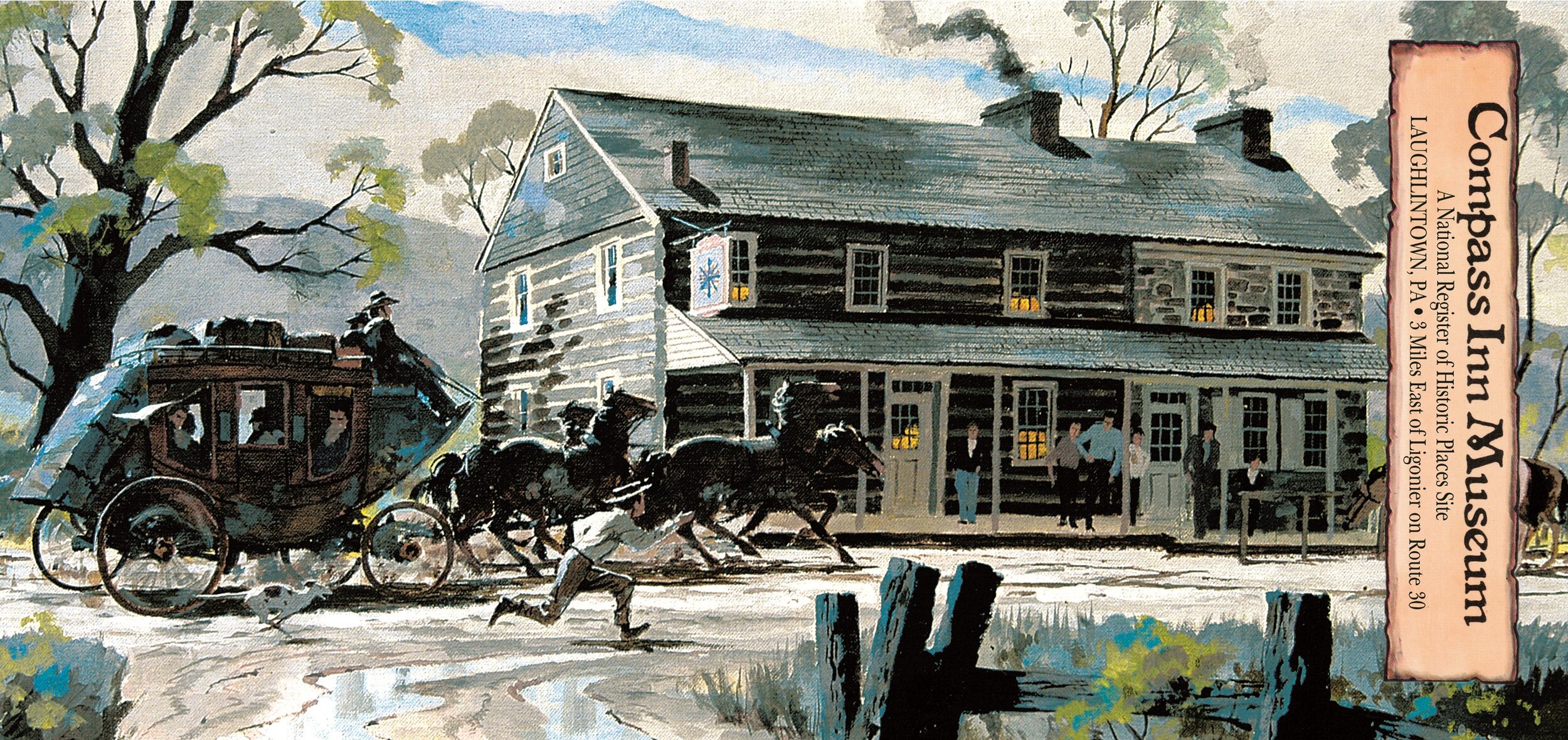The History of Compass Inn Museum
Shortly after the founding of Laughlintown in 1797 by Robert Laughlin, a man by the name of Philip Freeman purchased the land where Compass Inn now stands. This site was an ideal location for an inn. Situated at the base of Laurel Hill along the Pennsylvania State Road, Laughlintown experienced a tremendous amount of traffic from people travelling along the state road. Freeman built the log portion of the inn in 1799. His inn catered to drovers, workers who drove animals to and from market. Behind the inn on the land south of today’s Weimer Avenue, Freeman also built a horse barn with an adjacent pasture area for the drovers’ livestock.
Pittsburgh Artist, Nat Youngblood’s painting of the old Compass Inn.
The inn changed hands several times in the early 1800s. In 1807, Freeman sold the inn to Benjamin Johnston, who was innkeeper for about six years. Visitors to Compass Inn Museum today can view Johnston’s original liquor license that permitted him to legally sell spirits at the inn. Johnston sold the inn to Frederick Meyers in 1813. Meyers ran the inn just over a year and a half before selling to the establishment’s final proprietor, the Armor family.
When Robert and Rachel Armor arrived in Laughlintown in 1814, the Philadelphia-Pittsburgh Turnpike was being constructed, roughly along today’s Route 30. The Armors left their home in Chester County with plans to get into Pittsburgh’s rapidly-developing glass industry. However, their plans changed somewhere along their journey. They instead decided to purchase the log inn in Laughlintown from Frederick Meyers, the owner at the time. They renamed the establishment Compass Inn—in honor of the inn they previously ran in their eastern Pennsylvania hometown, Compassville.
With the Turnpike’s completion in 1817, traffic along the road increased substantially. Robert and Rachel decided to expand the inn and cater to a wealthier clientele—stagecoach passengers. In order to accommodate well-to-do stagecoach travelers, Compass Inn underwent a major expansion in 1820. The Armors added a stone wing, enlarging the common room and adding a formal ladies’ parlor and additional sleeping spaces upstairs. They also added a cookhouse and a horse barn that probably housed a blacksmith forge. Stagecoach stops such as Compass Inn provided everything weary travelers would need. The inn and cookhouse provided rest and food for the travelers, while the barn and forge provided rest and repairs for the animals and coaches.
Compass Inn was a fully functioning inn until 1862, when railroads and canals finally displaced traffic along the turnpike. Despite closing the inn, the Armor family called the property home for seven generations, taking it through several transformations.
Immediately following the closure of the Inn, Robert and Rachel’s son, John G. Armor, made significant renovations to the property. The common room was converted into a general store, and the remaining structure became the family’s private residence. John G. also added a kitchen on the back of the building. The general store in the former common room served as the local post office and polling station for a number of years. After John G. and his wife Catherine Russell died in the late 1800s, their sons Charles and Frank continued to run the family store, which by this time had been moved to a new building across the street (this building is still extant). Frank and Charles also operated a museum where they displayed antiques, photographs, and other relics to the public.
In 1966, Ligonier Valley Historical Society accepted Compass Inn as a gift from the Richard King Mellon Foundation. The Inn underwent extensive restoration and by 1972 opened as a museum and historic site for thousands of visitors each year. By 1980, the architectural firm Stotz, Hess and MacLachlan constructed a working cookhouse and blacksmith shop, as well as a barn, which houses an 1830s-style Concord Stagecoach and a restored Conestoga Wagon. Today, period-dressed docents guide visitors through the Inn, transporting them back in time to the 1830s when the Inn was at its busiest.












